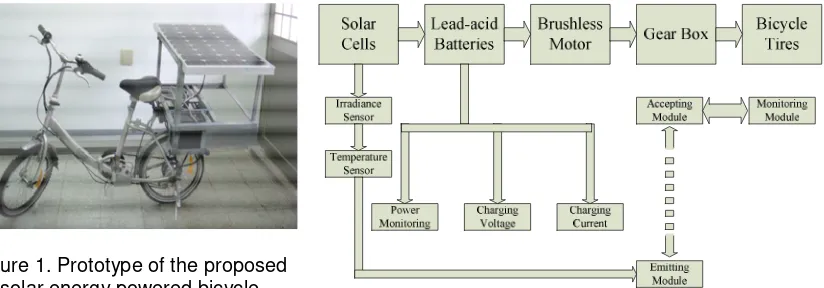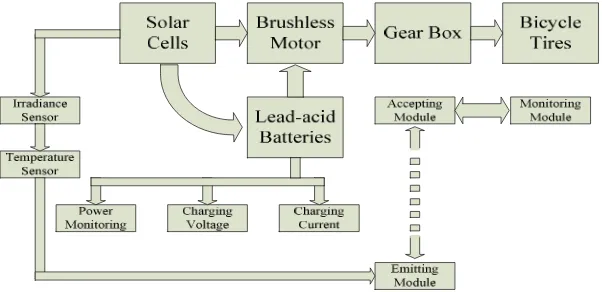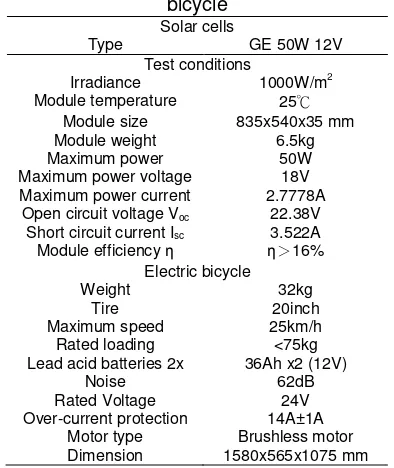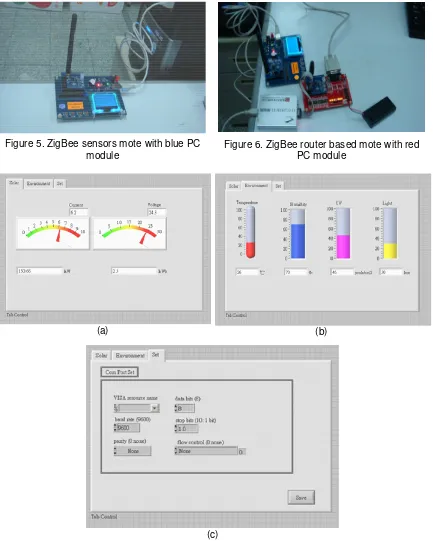ISSN: 1693-6930
accredited by DGHE (DIKTI), Decree No: 51/Dikti/Kep/2010 483
A Remote Power Management Strategy for the Solar
Energy Powered Bicycle
Chung-Hsing Chao
Department of Electrical Engneering, Ta-Hwa Institute of Technology
1 Ta-Hwa Road, Chiunglin, Hsichu, 30743, Taiwan, Ph./Fax:886-3-5927700 ext.2551/5924656 e-mail:[email protected]
Abstrak
Pada makalah ini diusulkan sepeda energi surya yang dilengkapi jaringan sensor nirkabel (JSN) yang memonitor transfer energi surya ke penyimpanan energi listrik dan menganalisis efektivitasnya. Guna mencapai tujuan ini dirakit sebuah an embarked ZigBee dengan sepeda bertenaga surya yang dilengkapi sistem supervise nirkabel. Hasil eksperimen membuktikan bahwa purwarupa sepeda bertenaga surya ini dapat mengelola energi surya untuk pengisian dua pak baterai Lead-Acid. Hasil penelitian juga menunjukkan bahwa pengguna dengan jaringan nirkabel pada periode parkir mengetahui data tentang jumlah radiasi matahari langsung, tingkat pencahayaan, suhu lingkungan, dan informasi kapasitas penyimpanan energi listrik melalui antarmuka internet.
Kata kunci: energy solar, manajemen daya secara remote, sepeda listrik
Abstract
In this paper, a solar energy powered bicycle by a wireless sensor network (WSN) far-end network monitoring solar energy to transfer the electrical energy storage and the effectiveness analysis is proposed. In order to achieve this goal, an embarked ZigBee by a solar-powered bicycle the far-end wireless network supervisory system is setup. Experimental results prove that our prototype, the solar energy powered bicycle, can manage the solar energy for charging two Lead-Acid batteries pack. As a result, the user by the wireless network in parking period knows the data on the amount of immediate solar radiation, the degree of illumination, the ambient temperature, and electrical energy storage capacity information by the internet interface.
Keywords: electric bicycle, remote power management, solar energy
1. Introduction
With the increasingly wide range of applications for renewable energy and wireless network technology, the conventional supervisory control and data acquisition (SCADA) system that employs power cable deployment for the remote terminal units and data line network between the monitoring end point and SCADA host center can be replaced. Take advantage of renewable energy resources in the transportation’s environment, offers a power source limited by the transportation’s physical survival rather than an adjunct energy source. This study examines “A Remote Power Management Strategy for the Solar Energy Powered Bicycle”. The integration of renewable photovoltaic energy and wireless network technology enables a remote terminal units located in an open outdoor area to conduct on-site monitoring with photovoltaic power through a ZigBee wireless module, transmitting data back to SCADA host center without physical wiring. Considering the unreliability of photovoltaic power systems, this study also makes an in-depth understanding on the availability of photovoltaic energy. Moreover, the unreliability of photovoltaic energy also makes user understanding residual electrical energy crucial.
using ZigBee under media access control (MAC) construction. Pegatoquet et al. [3] used a system-on-a-chip (SOC) chip, the digital signal processor (DSP), the micro control unit (MCU), the GSM, the Bluetooth, the global positioning system (GPS) to apply in the audio applications.
This study integrates solar energy renewable energy sources, the WSN and the wireless internet three units, and abbreviates power line's arrangement. Using lays aside on solar-powered bicycle's sensor element launcher, the user can know the data of the solar immediate degree of illumination, the solar generate electrical power rate, the ambient temperature, the storage electrical energy and so on.
2. System Structure
This topic is carried on the solar energy powered bicycle as shown in Fig. 1 by the WSN far-end network monitoring solar energy to transfer the electrical energy storage and the effectiveness analysis. In order to achieve this goal, an embarked ZigBee by a solar-powered bicycle the far-end wireless network supervisory system is setup. As a result, the user by the wireless network in parking period knows the data on the amount of immediate solar degree of illumination, the ambient temperature, and electrical energy storage capacity information by the internet interface. Further experiment results will be shown to verify a remote power management strategy for the solar energy powered bicycle with the proposed WSN far-end network monitoring solar energy system.
3. WSN in Campus Applicationss
There are several outdoor applications that seem feasible for WSNs. But to eliminate their dependence on batteries and use solar cells as an exclusive energy source would require the outdoor lights to be on continuously in the daytime [4]. A simplified block diagram of a wireless router node operating on solar energy are shown with series and parallel connected in Fig. 2 and Fig. 3, respectively. Typically, a router node consists of an eight bit microprocessor with adequate resources to operate its kernel [5]. The microcontroller manages power to the sensors and data acquisition elements, as well as responds to commands from the base station. ZigBee ready radio frequency transceiver [1] integrated with an eight bit microcontroller and the system communicates in the 2.4 GHZ frequency band. In this section, it is explained the results of research and at the same time is given the comprehensive discussion. The present result and Patent [6] can be presented in figures, graphs, tables and others that make the reader understand easily.
Figure 1. Prototype of the proposed solar energy powered bicycle
Figure 2. The series connected monitoring block diagram
the devices physical survival rather than an adjunct energy source likes sockets or the battery charging station demand. However, the design of an efficient energy harvesting module involves complex tradeoffs due to the interaction of several factors such as the characteristics of the energy sources and environment. It is therefore essential to thoroughly understand and judiciously exploit these factors in order to maximize the energy efficiency of the solar cells module.
Figure 3. The parallel connected monitoring block diagram
Due to the unstable characteristic for solar energy, it is more convenient to allow electric bicycles to run on stable sources of energy such as batteries. The maximum range of data transmission for such ZigBee is approximately one hundred meters [3]. Thus, additional nodes may be required to pass the data back to the central monitoring location. There might be several such router nodes distributed in these WSNs, and number would depend on campus size and coverage requirements. Typically, each router node in the network has a fixed location and its only function involves establishing itself in the network and enabling prompt data transfer to the nearest router node or base station. These router nodes obviously need to be continuously on so that data can be promptly transferred. Since the unstable solar power in the outdoor that harvests in the daytime, it is advantageous to get continuously data for scavenging solar energy. This would result in a cost saving overtime and eliminate the need to charge batteries.
Referring to Fig. 2 again, the base station in such networks consists of a router that receives data and is connected to a server. The data received by the base station is displayed to allow continuous monitoring and can be routed to the battery’s characteristics for easy access in real time. Similarly, ZigBee sensors in the solar powered bicycle with the solar cells can scavenge energy through overhead sunlight rather than use battery charger. In fact, in such systems, ZigBee sensors might be mobile and therefore, it might be possible and advantageous to monitoring the electric power in the batteries through photovoltaic solar cells [5],[7], [9], [10].
There are two key issues that were addressed before embarking upon designing the solar powered bicycle for wireless supervisory monitoring applications. First, solar energy has to be harvested by an efficient energy scavenging system. Secondly, there has to be an efficient means of storing this harvested energy. The system must also effectively deliver the stored energy data to the remote user knows what the miles he or she can use to run the solar powered bicycle. This means there has to be an intelligent power management strategy in place. Obviously, this strategy must know how much the stored energy can use and where can be recharging the batteries. These details along with design considerations that impact efficiency and the associated tradeoffs are explained in the next few sections.
3.1. Solar Cells Characteristic
determine the number of panels required per solar powered bicycle, a simple load test was conducted. A single solar panel was connected across a varying load to determine its V-I profile. Fig. 4 shows the V-I profile wherein it can be observed that at around 18 VDC the panel sourced out approximately 3 A. Therefore, 50W solar panel was enough to recharging lead acid batteries. Although the size of the panels was not a concern, a modularized approach was taken in order to reduce the panel size and weight further. It was assumed to use the solar power with 1/3 duty cycle in the daytime that the system is always power on to charging the batteries. In addition, two lead acid batteries 12VDC 36Ah were used in parallel with the solar panels to store the solar energy and to reduce the solar panel power rating requirement even further. These details are explained in the next few sections.
Table 1. The specification of the solar powered bicycle Lead acid batteries 2x 36Ah x2 (12V)
Noise 62dB
Rated Voltage 24V Over-current protection 14A±1A
Motor type Brushless motor Dimension 1580x565x1075 mm
Figure 4. V-I characteristics of a GE 50W solar panel
3.2. A Remote Power Management Strategy
An energy harvesting scheme was used for solar energy powered bicycle. It consists of an adequate number of solar cells to charge the energy storage devices which in turn output regulated power to recharge a lead acid battery and another lead acid battery for discharge. Probably, this strategy works well for an electric bicycle where adequate solar energy in the daytime is available to charge the energy storage devices. However, in many outdoor applications, solar energy scavenging from 50W solar panel is fairly practical. This strategy was utilized to obtain power for the driving or stopping period in the daytime. The core of the energy harvesting module is the power management circuit which draws power from the solar panels and manages energy storage and power routing to electric motor. The most important consideration in the design of scavenging energy is to maximize energy efficiency, enhance device reliability, and lengthen the miles of electric bicycle. The power management circuit designed for this system provides regulated power in lead acid batteries.
3.3. Experimental Results
sensors mote, ZigBee router based mote (red PC module) and the solar powered bicycle monitoring screen are shown in Fig. 5, Fig. 6 and Fig. 7 respectively. It is showed that the proposed electric bicycle charging source by solar cells may lengthen the travel distance and reduce the manual charge the trouble. By using ZigBee and GSM network which in monitoring the stored energy data from picking up the system about the solar electrical energy generation, the battery charge, and the surplus electrical power system can obtain the immediate information rapidly on the surveillance bicycle by the network.
Figure 5. ZigBee sensors mote with blue PC module
Figure 6. ZigBee router based mote with red PC module
(a) (b)
(c)
4. Conclusion
This study is carried on the solar energy powered bicycle by the WSN far-end network monitoring solar energy to transfer the electrical energy storage and the effectiveness analysis. In order to achieve this goal, an embarked ZigBee by a solar-powered bicycle the far-end wireless network supervisory system is setup. As a result, the user by the wireless network in parking period knows the data on the amount of immediate solar degree of illumination, the ambient temperature, and electrical energy storage capacity information by the internet interface. The electric bicycle with two sets of 36Ah lead-acid batteries and the 50W solar cell in the back seat, which was conducted to test when the summer and sunny weather, only depends on the built-in batteries to run, the kilometers traveled distances away from probably is 36.5km, if the use solar cell charge, increases to 54.4km. In the winter, the experimental result respectively is 36.4km and 45.9km. The experimental results were shown to verify the feasibility of the proposed WSN far-end network monitoring solar energy system.
References
[1] ZigBee Alliance, http://www.zigbee.org/.
[2] Valente A, Morais R, Serodio C, Mestre P, Pinto S, Cabral M. A ZigBee Sensor Element for Distributed Monitoring of Soil Parameters in Environmental Monitoring. Sensors. 2007; 135-138.
[3] Pegatoquet A, Thoen F, Paterson D. Virtual Reality for 2.5 G Wireless Communication Modem
Software Development. 32nd Annual IEEE International Computer Software and Applications. Turku.
2008; 72-75.
[4] Shin DI, Shin KH, Kim IK, Park KS, Lee TS, Kim SI, Lim KS, Huh SJ. Low Power hybrid Wireless Network for Monitoring Infant Incubators. Medical Engineering & Physics. 2005; 27 (6): 713-716.
[5] Hande A, Polk T, Walker W, Bhatia D, Indoor solar energy harvesting for sensor network router nodes. Microprocessors and Microsystems. 2007; 31(4): 420-432.
[6] Chao CH, Shieh JJ. A Solar Charging Battery Powered Electric Vehicle with Remote Control Operation. Taiwan No. M-399536, (Patent). 2011.
[7] Churchill DL, Hamel MJ, Townsend CP. Strain Energy Harvesting for Wireless Sensor Networks.
Smart Structures and Materials, inSPIE. 2003; 5005: 319-327.
[8] Jaralikar SM, Aruna M. Case Study of a Hybrid (Wind and Solar) Power Plant. TELKOMNIKA Indonesian Journal of Electrical Engineering. 2010; 8(2): 19-26.
[9] Paradiso JA, Starner T. Energy Scavenging for Mobile and Wireless Electronics. Pervasive
Computing, IEEE CS and IEEE ComSoc, 2005; 4(1): 18-26.



